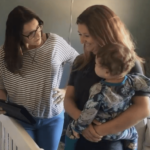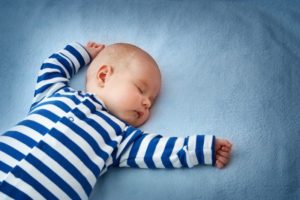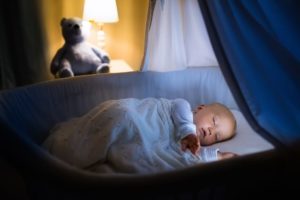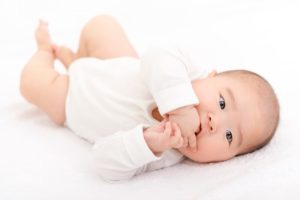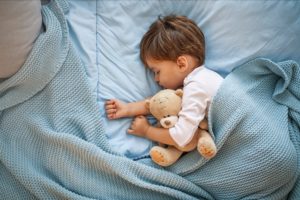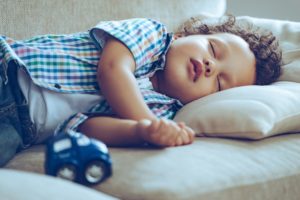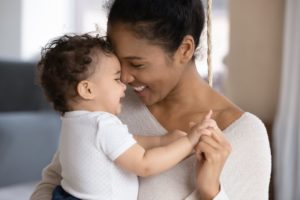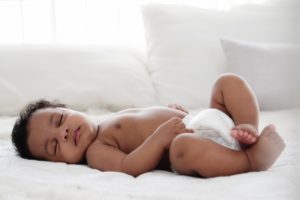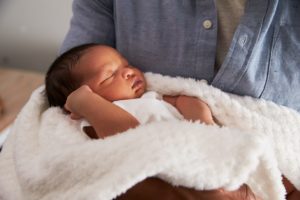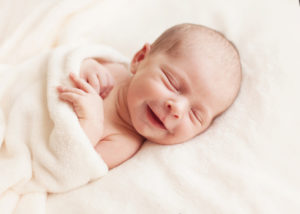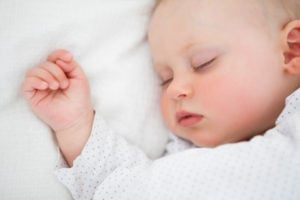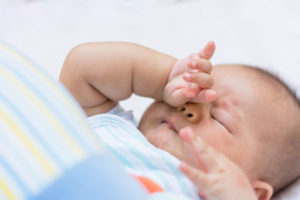When you buy through our links, we may earn a commission. Products or services may be offered by an affiliated entity. Learn more.
What Is the Best Room Temperature for a Sleeping Baby?
- Why Is Room Temperature Important for Sleeping Babies?
- How to Keep the Right Room Temperature for Your Baby
- Signs Your Baby Is Too Hot or Too Cold
- Tips for Keeping Your Baby Safe and Comfortable During Sleep
- When to Talk to Your Pediatrician
- Frequently Asked Questions About Room Temperature and Babies
Establishing good sleep habits for your baby early on sets them up for better sleep throughout childhood and contributes to their cognitive and physical development. To enjoy restful sleep, babies need a safe and comfortable sleep environment. When setting up the nursery, many parents wonder what is the ideal baby room temperature.
In general, room temperatures that are comfortable for adults are also appropriate for babies, but there are other important factors to consider when building a safe sleep environment. We discuss the optimal room temperature for a sleeping baby and other tips for improving infant sleep.
Why Is Room Temperature Important for Sleeping Babies?
A comfortable bedroom temperature helps promote better sleep. A bedroom that is too hot or too cold may affect sleep quality and lead to nighttime awakenings.
Whether from a warm bedroom temperature or too many layers of pajamas, overheating can also increase a baby’s risk of sudden infant death syndrome (SIDS). It takes time for babies to develop their sleep cycles and be able to self-regulate their temperature . They also sweat less , which helps adults cool down.
Help Your Baby Sleep Better With Pediatric Sleep Coaching
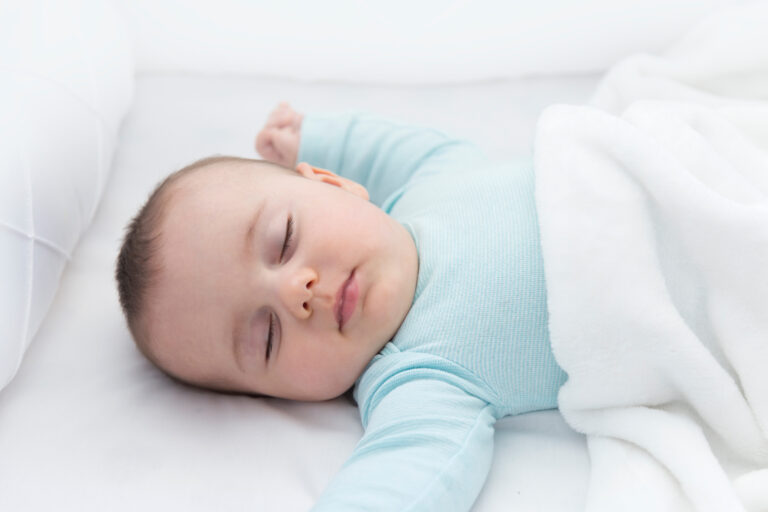
our partner at sleepdoctor.com
Schedule a Free Consultation Today
Learn More“Life-changing! My anxiety about my son’s sleeping habits were immediately reduced after talking to Sara. She went above and beyond to tailor a schedule to our goals, answer our questions, keep us on track, and check in to encourage us when we just thought we couldn’t do it anymore.”
Rachael B. – Verified Customer
How to Keep the Right Room Temperature for Your Baby
There are several ways you can help your baby’s bedroom stay at a consistently cool, but not cold, temperature:
- Stay Close: Check on your baby frequently during naps, and keep their crib in your room until they reach 12 months old so you can better monitor your baby’s temperature.
- Set the Thermostat Cautiously: Bedroom heating has been implicated as a risk factor for SIDS. Consider using a separate thermostat for the bedroom or purchasing an indoor thermometer so you can better control the bedroom temperature.
- Avoid Direct Heat and Cold Sources: Especially for very young babies, place the crib away from windows, radiators, or other items that may influence the ambient temperature around their crib.
- Keep Cool in the Summer Months: When it is warm outside, take extra care to keep the room temperature cool and use a fan or air conditioning if needed, keeping the fan angle away from your baby.
- Consider the Infant’s Developmental Stage: Preterm babies take a bit more time to regulate their body temperature , so you may keep the temperature slightly warmer while watching them carefully for signs of overheating.
A number of factors can affect room temperature, from the type of insulation to the room’s location within the house. For example, bedrooms on a higher floor tend to have warmer temperatures. Be mindful of how the temperature might change within the house, and consider choosing cooler rooms for the family to sleep in during the summer months.
Signs Your Baby Is Too Hot or Too Cold
Sweating and feeling hot to the touch can be signs of overheating. If your baby gets too cold, their skin may feel cool to the touch, or they may shiver. Pale or grey skin, breathing difficulties, limpness, vomiting, feeding difficulties, irritability, and fatigue can all be signs of hypothermia.
To check your baby’s temperature, touch your baby’s chest or abdomen, as these areas can give you a more accurate reading. If the room temperature is at a comfortable temperature but your baby appears too hot or too cold, contact your pediatrician.
Tips for Keeping Your Baby Safe and Comfortable During Sleep
When your baby is safe and comfortable, the whole family sleeps better. Here are a few more ways you can keep your baby safe during sleep.
- Share A Room, Not A Bed: Until they reach their first birthday, it is safest for a baby to sleep in their own crib to reduce the risk of suffocation.
- Put Your Baby on Their Back to Sleep: Place your baby on their back every time they go to sleep, up until they are 1 year old. This includes during naps.
- Keep Extra Items Out of the Crib: Use a safety-approved crib that contains only a firm mattress and a snug fitted sheet. Nothing else should be in the crib, including stuffed animals, pillows, blankets, or other sheets.
- Dress Your Baby in Temperature-Appropriate Clothing: Choose sleepwear for your baby that is appropriate for the temperature. Babies may benefit from one extra layer than an adult would need, but avoid covering the face and head. In cold temperatures, a wearable blanket can keep them comfortably warm and is considered safer than a blanket.
- Safely Swaddle: If swaddling your baby, place them on their back and use a light fabric. Once your baby starts learning to roll over, stop swaddling them as it can be dangerous if they roll onto their stomach while swaddled.
- Follow a Bedtime Routine: Help your baby prepare for sleep with a calming bedtime routine involving the same set of restful activities each night, such as reading, singing a lullaby, or cuddling.
When to Talk to Your Pediatrician
Keep an eye out for signs that your baby is too cold or too hot, and contact your pediatrician if their skin stays cool or warm to the touch despite changing the temperature. This is especially important if they have other symptoms that suggest they may be sick, like a fever, vomiting, or diarrhea . Avoid over-bundling your baby if they have a fever or chills.
Frequently Asked Questions About Room Temperature and Babies
What Is the Ideal Temperature for a Sleeping Baby?
Some studies have found that a room temperature between
68 and 72 degrees Fahrenheit
may be comfortable for babies. However, the American Academy of Pediatrics (AAP) refrains from providing a specific temperature range for the baby’s bedroom. Instead, the AAP recommends dressing the baby in clothing that is appropriate for ambient temperatures.
The optimal room temperature for a sleeping baby might depend on the typical climate in your region. For example, babies who are accustomed to warmer climates might be able to handle a slightly warmer room temperature. Experts note that strong air conditioning in the summer or excessive heating in the winter can also be dangerous for babies.
What Room Temperature Is Too Hot for a Baby?
A baby room temperature above 72 degrees Fahrenheit, or 22 degrees Celsius, may be too warm. An older study from California found that using a fan when temperatures rose above 70 degrees was associated with a
lower risk of SIDS
.
Along with the room temperature, it is just as important to ensure that the baby is appropriately dressed in clothing that helps maintain a comfortable body temperature. If their chest feels warm to the touch, lower the temperature or remove layers of clothing to help them cool down.
Do Babies Sleep Better in a Cold Room?
Babies tend to sleep better in a comfortably cool room. Because babies have a greater proportion of exposed surface area for their weight, it is easier for them to lose body heat. This is why the American Academy of Pediatrics recommends giving them one extra layer compared to what an adult would feel comfortable wearing.
How Do You Know If Your Baby Is Too Cold?
An overly cold baby may shiver or feel cool to the touch. If you notice signs that your baby is too cool, increase the room temperature or add an extra layer of clothing. Seek immediate medical attention if these signs are accompanied by lethargy, pale or dull skin, breathing difficulties, limp muscles, vomiting, unexplained irritability, or feeding problems.

Still have questions? Ask our community!
Join our Sleep Care Community — a trusted hub of sleep health professionals, product specialists, and people just like you. Whether you need expert sleep advice for your insomnia or you’re searching for the perfect mattress, we’ve got you covered. Get personalized guidance from the experts who know sleep best.
References
7 Sources
-
Joseph, D., Chong, N. W., Shanks, M. E., Rosato, E., Taub, N. A., Petersen, S. A., Symonds, M. E., Whitehouse, W. P., & Wailoo, M. (2015). Getting rhythm: How do babies do it? Archives of Disease in Childhood. Fetal and Neonatal Edition, 100(1), F50–F54.
https://pubmed.ncbi.nlm.nih.gov/25245173/ -
Arnold, C. (2015). New risk factor for SIDS? Peaks in cot deaths associated with heat waves. Environmental Health Perspectives, 123(7), A185.
https://pubmed.ncbi.nlm.nih.gov/26131650/ -
Auger, N., Fraser, W. D., Smargiassi, A., & Kosatsky, T. (2015). Ambient heat and sudden infant death: A case-crossover study spanning 30 years in Montreal, Canada. Environmental Health Perspectives, 123(7), 712–716.
https://pubmed.ncbi.nlm.nih.gov/25748025/ -
Lunze, K., Bloom, D. E., Jamison, D. T., & Hamer, D. H. (2013). The global burden of neonatal hypothermia: Systematic review of a major challenge for newborn survival. BMC Medicine, 11, 24.
https://pubmed.ncbi.nlm.nih.gov/23369256/ -
A.D.A.M. Medical Encyclopedia. (2022, February 4). When your baby or infant has a fever. MedlinePlus.
https://medlineplus.gov/ency/patientinstructions/000319.htm -
Tsogt, B., Manaseki-Holland, S., Pollock, J., Blair, P. S., & Fleming, P. (2016). Thermoregulatory effects of swaddling in Mongolia: A randomised controlled study. Archives of Disease in Childhood, 101(2), 152–160.
https://pubmed.ncbi.nlm.nih.gov/26515228/ -
Coleman-Phox, K., Odouli, R., & Li, D. K. (2008). Use of a fan during sleep and the risk of sudden infant death syndrome. Archives of Pediatrics & Adolescent Medicine, 162(10), 963–968.
https://pubmed.ncbi.nlm.nih.gov/18838649/




